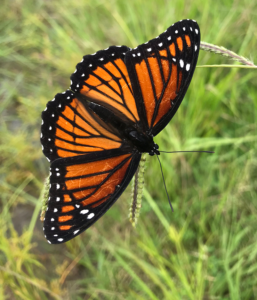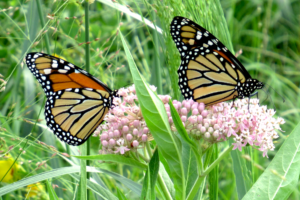Updated March 21, 2025: The USFWS reopened the comment period until May 19, 2025, adding 60 days to the original 90-day period that began in December 2024.
The U.S. Fish and Wildlife Service (USFWS) announced in the Federal Register on December 12, 2024 its intention to list the monarch butterfly (Danaus plexippus) as threatened under the Endangered Species Act (ESA), a move that will have major implications for land management and development. This is a much-anticipated step in safeguarding the iconic pollinator. It has implications for the regulated community at large given that the USFWS models routinely identify monarch butterfly populations or predict potential habitat in project sites across the U.S., from transportation and utility infrastructure to homebuilding and commercial development. Note, the proposed rule does not immediately list the monarch butterfly under the ESA but does start the typically one-year process resulting in a final rule.
Endangered Species Act (ESA), a move that will have major implications for land management and development. This is a much-anticipated step in safeguarding the iconic pollinator. It has implications for the regulated community at large given that the USFWS models routinely identify monarch butterfly populations or predict potential habitat in project sites across the U.S., from transportation and utility infrastructure to homebuilding and commercial development. Note, the proposed rule does not immediately list the monarch butterfly under the ESA but does start the typically one-year process resulting in a final rule.
Why Is This Happening?
The threatened listing follows years of declining monarch populations, driven by habitat loss, climate change, pesticide/insecticide use, and dwindling nectar and milkweed resources that are necessary for the monarch’s life cycle.
What Impact Can This Listing Have?
The proposed listing is accompanied by a 4(d) rule and designated critical habitat (in coastal California) for the species. The listing under the ESA prohibits “take¹” of the species, while the 4(d) rule provides exemptions for certain activities.
This proposed 4(d) rule includes provisions that allow exemptions for activities that can positively contribute to quality habitat and maintaining public support for monarch butterfly conservation. Those include implementation of a comprehensive conservation plans; and some land use activities (agriculture, livestock/ranching, silviculture and residential maintenance) that may maintain, enhance, remove, or establish milkweed and nectar plants within the breeding and migratory range that do not result in conversion of native or naturalized grassland, shrubland, or forested habitats. There is also an exemption for vehicle strikes.
Why Is This Important?
The USFWS proposed listing does not appear to offer exemptions for many development and management activities in the lower 48 states. As such, project proponents will be faced with new limitations and additional environmental protection measures consistent with achieving monarch species recovery goals.
Some details are not yet defined, including the definition of quality habitat locations, limits to activities, and protection measures. However, the proposed listing expressed that comprehensive conservation plans and programs like the Monarch Candidate Conservation Agreement with Assurances (CCAA) would play a significant role in helping to restore and protect monarch butterfly habitats. The USFWS has said it will provide more information in the coming year on the comprehensive conservation plans.
While the proposed listing did not go into detail on the requirements for comprehensive conservation plans or specific conservation measures, they may be similar to those seen in other pollinator programs (including the Monarch CCAA), related to:
- Time of year restrictions (conducting activities when the monarch is not present);
- Incorporating milkweed in supplemental seeding and habitat enhancement activities;
- Targeted vegetation management practices; and
- Idle lands management (suitable habitat lands managed without annual efforts for benefit of the monarch.)
What Happens Next?
The proposed rule does not immediately list the monarch butterfly under the ESA but does start the typically one-year process resulting in a final rule.
The USFWS is collecting public comments on the proposed listing through March 12, 2025 May 19, 2025.
WSSI will be monitoring this process and will provide updates in future issues of Field Notes.
Steps To Take Now
Provide Comments
Consider providing comments that relate to your experience and industry during the open comment period. The comment portal and comment guidance can be found on Regulations.gov when you search for docket FWS-R3-ES-2024-0137.
Public comments must be submitted no later than March 12, 2025 May 19, 2025.
Attend Virtual Public Information Meetings and Hearings
Visit Regulations.gov and search for docket FWS-R3-ES-2024-0137. As of this article’s publication, two public meetings have been scheduled:
- Register for the virtual meeting on January 14 (6:00 p.m. to 8:30 p.m. EST)
- Register for the virtual meeting on January 15 (8:00 p.m. to 10:30 p.m. EST)
Develop Your Strategy
This is a good time to evaluate which current and future projects may be subject to changes upon listing. WSSI can work with you and your project team to assess potential monarch butterfly habitat and concerns, and the possibility of your project impacting habitat or individuals. Additionally, consider providing comments to USFWS regarding the proposed listing and 4(d) rule prior to the March 12, 2025 deadline. Update: USFWS re-opened the period with an announcement in the Federal Register on March 19, 2025; the comment period closes May 19, 2025.
Work With WSSI
WSSI has a history of helping clients navigate new species listings, including the bat listings of recent years. Additionally, WSSI has been part of the Monarch CCAA program since its 2020 beginning, working with clients on implementing monarch protection measures and maintaining their standing in the first of its kind voluntary program. Our staff are prepared to help you determine how the proposed listing may impact your current and future projects.

¹“Take” is defined in the Endangered Species Act as “to harass, harm, pursue, hunt, shoot, wound, kill, trap, capture, or collect, or to attempt to engage in any such conduct.”
